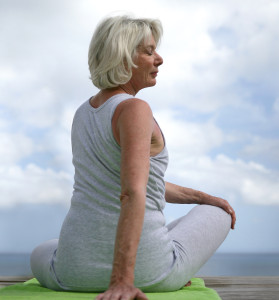Arthritis Pain – Manage It with Music and Yoga!
Good Everyday Ideas
During the day, if you’ve been sitting, adjust your position frequently. Periodically tilt your neck from side to side. Bend and stretch your legs. Pace yourself. Take breaks so that you don’t over use a single joint and cause more pain. Stand up and walk around every 30 minutes. Try gentle exercise in the evening and you will feel less stiff in the morning. See a physical therapist to help you develop and exercise program that’s right for you. Call AW Health Care. Our physical therapists are trained to work with seniors experiencing pain problems. We can help right in your home to learn proper exercises.
Music
Imaging studies have shown that music can be great therapy for pain, especially the pain of osteoarthritis. Music can stimulate the brain’s pleasure center to increase brain chemicals that inhibit pain. Classical music is a good choice to try. Pay attention to your breathing and heart rate while listening. If your breathing slows down, stress will melt away. Some good composers to try are Beethoven, Chopin and Vivaldi.
Yoga Laughter
You might be thinking, “What’s Yoga Laughter?” But don’t be skeptical. Where there’s laughter, pain usually subsides. A good laugh feels good. That’s how Yoga Laughter, a form of laughter therapy, got started. It began in 1995 with an Indian medical doctor, Madan Kataria. Dr. Kataria uses playful activities and guided breathing exercises to trigger laughter. This form of therapy has spread to more than 50 countries with about 200 “laughter clubs” in the U.S. alone. When people laugh they release endorphins, feel-good hormones which are natural pain killers. Janet Wilson, an RN in Flagstaff, Arizona suffers from fibromyalgia. She became a certified laughter leader in 2005 and now runs a “laughter club.” “I have had chronic pain for 12 years. I love leading laughter sessions because it elevates my mood and provides pain relief that lasts for about two hours,” says Janet. (Source: Arthritis Foundation)
Medications
There are many different types of drugs used to treat arthritis pain which include over-the-counter and prescription-only drugs, injections, infusions, patches and topical agents:
Nonsteroidal Anti-inflammatory drugs (NSAIDs, like aspirin or Ibuprophen) treat mild muscle aches but arthritis patients take NSAIDS at higher does to reduce joint inflammation.
Analgesics (like Tylenol) fight pain but not inflammation; others called opioids may be used for arthritis flares; suitable for short term use because they cause physical dependence and constipation.
Corticosteroids fight inflammation and are taken orally as pills, absorbed through the skin as topical agents, or injected directly into inflamed joints.
Disease-modifying anti-rheumatic drugs (DMARDS like Methotrexate) suppress the body’s immune system and are effective treatments for rheumatoid arthritis, psoriatic arthritis and lupus. DMARDs are often taken with other medications like NSAIDs.
Biologics (like Xeljanz, Humira or Enbrel), called biologic response modifiers, also suppress the immune system and can stop joint damage from occurring. They do not cure arthritis but can put the disease into remission.
Antidepressants (like Cymbalta or Lyrica) can reduce pain because body chemicals that affect mood also affect pain.
Topicals are available in either over-the-counter or by prescription and come as a cream, gel, ointment, spray or patch, and are quick and convenient relief of localized pain.
Muscle Relaxants target pain caused by tight muscles or soft tissues but can cause drowsiness and dependence.
Nerve blocks, an injection like lidocaine, temporarily block severe pain caused by ganglion or plexus nerves
Don’t forget. Mother’s Day is May 10!







Comments are closed.